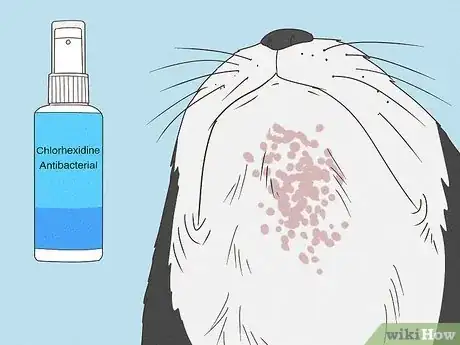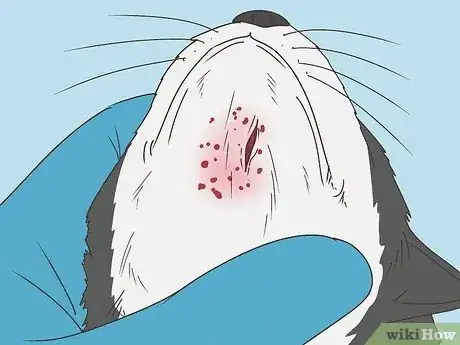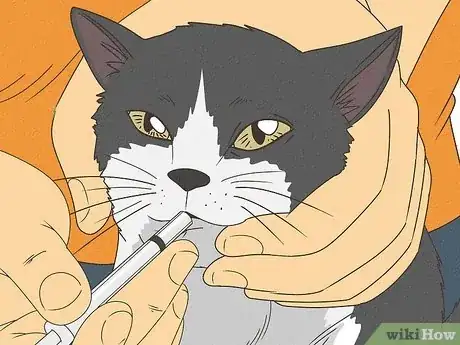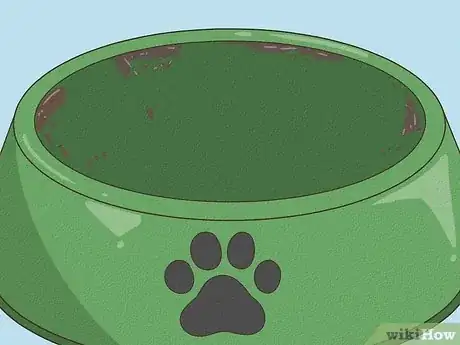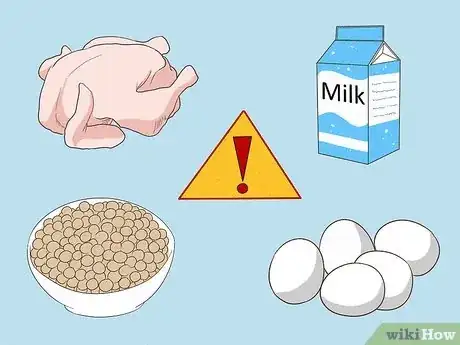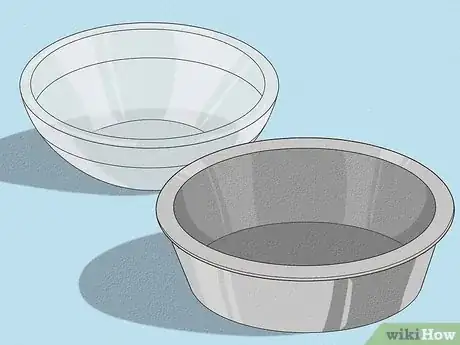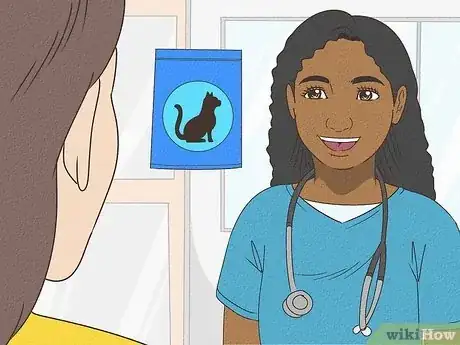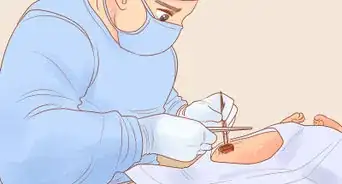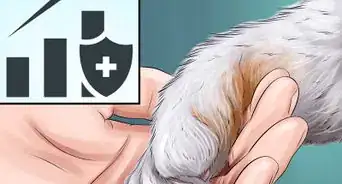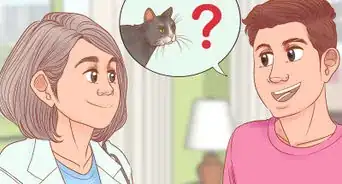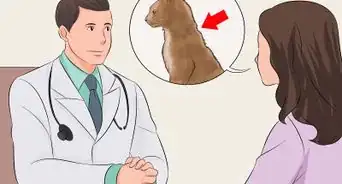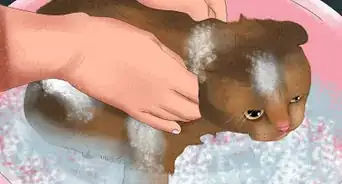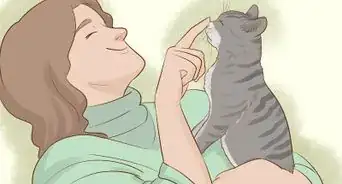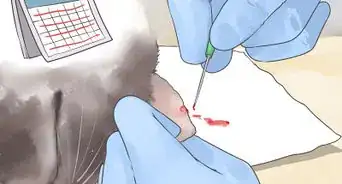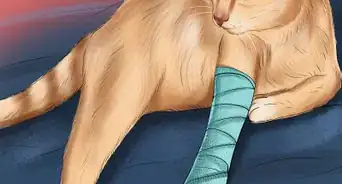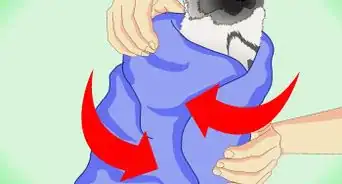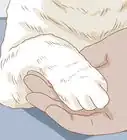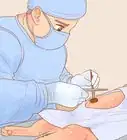This article was co-authored by Natalie Punt, DVM and by wikiHow staff writer, Hunter Rising. Dr. Natalie Punt is a Veterinarian and the Founder and CEO of mPet- a smart phone app for pet owners to store, manage and transfer their pets medical records and health information. She specializes in small animal emergency and general medicine and veterinary practice economics. Dr. Punt holds a BS in Biochemistry and Molecular Biology from The University of California, Davis, an MS in Biochemistry from The University at Buffalo, and a DVM from Western University of Health Sciences.
There are 15 references cited in this article, which can be found at the bottom of the page.
wikiHow marks an article as reader-approved once it receives enough positive feedback. This article received 15 testimonials and 100% of readers who voted found it helpful, earning it our reader-approved status.
This article has been viewed 410,833 times.
Have you noticed small black spots around your cat’s chin? If so, your furry friend may be dealing with a bit of feline acne. While most minor cases are nothing to worry about, more severe cases may irritate your cat or lead to infection. The good news is there are a lot of easy ways to treat and prevent cat acne right at home before you need to see a vet. We know you’ve got more questions about feline acne, so keep reading to learn everything you’ll need to know to make your cat look and feel better.
Things You Should Know
- Minor cases of cat acne don’t require any treatment and may disappear on their own.
- Put a warm compress on cat acne to help open the pores and bring down inflammation.
- Wash cat acne with a chlorhexidine antibacterial wash to kill germs that lead to infection. Alternatively, you can use a benzoyl peroxide shampoo.
- Visit a vet if your cat develops large pimples or open lesions. They’ll prescribe topical or oral antibiotics.
Steps
Vet Diagnosis and Treatment
-
1Take your cat to the vet if they have swollen pimples or open wounds. Feline acne usually looks like small black dots or dirt. If the blemishes swell up or look red and inflamed, it may mean there’s a sign of infection or bacteria. To be on the safe side, set up a vet appointment to make sure your cat doesn’t get sick or have any other conditions.[9]
- Cat acne is pretty common, so there’s no need to be concerned if you see fewer than 20 small black spots. They might not even bother your cat and could disappear on their own.[10]
-
2Have your vet take a skin sample to rule out other infections. Your vet will scrape a small sample from your cat’s skin to run tests. That way, they can make sure your cat isn’t suffering from a different skin condition with similar symptoms.[11]
- Your vet may also check the sample for mites, bacteria, or fungi as well.
-
3Give your cat antibiotics if your vet prescribes them. Your vet will either prescribe a topical or oral medication if your cat has a severe case of acne. To give your cat oral medication, either use a medicine dropper or mix it with their next meal. If you’re using a topical medication, rub it onto your cat’s acne so it absorbs into their skin.[12]
- You’ll usually have to give your cat antibiotics for 4–6 weeks.
- Your cat may need to take steroids to reduce inflammation in severe cases of feline acne.
Expert Q&A
-
QuestionWhat can I give my cat for acne?
 Natalie Punt, DVMDr. Natalie Punt is a Veterinarian and the Founder and CEO of mPet- a smart phone app for pet owners to store, manage and transfer their pets medical records and health information. She specializes in small animal emergency and general medicine and veterinary practice economics. Dr. Punt holds a BS in Biochemistry and Molecular Biology from The University of California, Davis, an MS in Biochemistry from The University at Buffalo, and a DVM from Western University of Health Sciences.
Natalie Punt, DVMDr. Natalie Punt is a Veterinarian and the Founder and CEO of mPet- a smart phone app for pet owners to store, manage and transfer their pets medical records and health information. She specializes in small animal emergency and general medicine and veterinary practice economics. Dr. Punt holds a BS in Biochemistry and Molecular Biology from The University of California, Davis, an MS in Biochemistry from The University at Buffalo, and a DVM from Western University of Health Sciences.
Veterinarian Ask your vet for a recommendation. they might suggest an antimicrobial, antibiotic, or antifungal medication.
Ask your vet for a recommendation. they might suggest an antimicrobial, antibiotic, or antifungal medication. -
QuestionHow do you get rid of cat acne?
 Melissa Nelson, DVM, PhDDr. Nelson is a Veterinarian who specializes in Companion and Large Animal Medicine in Minnesota, where she has over 18 years of experience as a veterinarian in a rural clinic. She received her Doctor of Veterinary Medicine from the University of Minnesota in 1998.
Melissa Nelson, DVM, PhDDr. Nelson is a Veterinarian who specializes in Companion and Large Animal Medicine in Minnesota, where she has over 18 years of experience as a veterinarian in a rural clinic. She received her Doctor of Veterinary Medicine from the University of Minnesota in 1998.
Veterinarian Using hydrogen peroxide on a cotton ball to scrub the affected skin will help remove the lesions (which are caused by a buildup of oils). You should be gentle with hydrogen peroxide though, and consider talking to a vet.
Using hydrogen peroxide on a cotton ball to scrub the affected skin will help remove the lesions (which are caused by a buildup of oils). You should be gentle with hydrogen peroxide though, and consider talking to a vet. -
QuestionWould a solution of apple cider vinegar and water soaked on a cotton ball and lightly used on the chin area work?
 Pippa Elliott, MRCVSDr. Elliott, BVMS, MRCVS is a veterinarian with over 30 years of experience in veterinary surgery and companion animal practice. She graduated from the University of Glasgow in 1987 with a degree in veterinary medicine and surgery. She has worked at the same animal clinic in her hometown for over 20 years.
Pippa Elliott, MRCVSDr. Elliott, BVMS, MRCVS is a veterinarian with over 30 years of experience in veterinary surgery and companion animal practice. She graduated from the University of Glasgow in 1987 with a degree in veterinary medicine and surgery. She has worked at the same animal clinic in her hometown for over 20 years.
Veterinarian The key to preventing feline acne or reducing the severity of a flare up is cleanliness. Any gentle cleaning solution when used regularly will help. Diluted salt water or diluted chlorhexidine are good options. Apple cider vinegar will have a mild astringent effect, so there is a risk of drying out the skin, but when used diluted, this should be minimal and the cleansing effect beneficial.
The key to preventing feline acne or reducing the severity of a flare up is cleanliness. Any gentle cleaning solution when used regularly will help. Diluted salt water or diluted chlorhexidine are good options. Apple cider vinegar will have a mild astringent effect, so there is a risk of drying out the skin, but when used diluted, this should be minimal and the cleansing effect beneficial.
Warnings
- Infected pimples or lesions could turn into painful bruises if you don’t treat cat acne. Contact your vet and set up an appointment as soon as you see any signs of infection, like pus or swelling.[25]⧼thumbs_response⧽
References
- ↑ https://assets.ctfassets.net/rt5zmd3ipxai/7K47SFihE2HeiP2dkk12oG/c82a6efb30aebafe58f8dbd573ab25c9/NVA_-_The_Cat_Doctor_241_-_Acne.pdf
- ↑ https://www.sciencedirect.com/topics/pharmacology-toxicology-and-pharmaceutical-science/chlorhexidine
- ↑ https://icatcare.org/advice/feline-acne-and-stud-tail/
- ↑ https://youtu.be/591dF1MLZvA?t=44
- ↑ https://vetmed.tamu.edu/news/pet-talk/managing-feline-acne/
- ↑ https://dailymed.nlm.nih.gov/dailymed/fda/fdaDrugXsl.cfm?setid=f9165b06-edf4-4040-af11-e311b659704f&type=display
- ↑ https://files.brief.vet/migration/article/8656/chin-dermatitis-in-a-cat-8656-article.pdf
- ↑ https://vetmed.tamu.edu/news/pet-talk/managing-feline-acne/
- ↑ https://youtu.be/Nds8LpY4jIo?t=54
- ↑ https://www.catwatchnewsletter.com/health/diagnosis-feline-acne/
- ↑ https://assets.ctfassets.net/rt5zmd3ipxai/7K47SFihE2HeiP2dkk12oG/c82a6efb30aebafe58f8dbd573ab25c9/NVA_-_The_Cat_Doctor_241_-_Acne.pdf
- ↑ https://icatcare.org/advice/feline-acne-and-stud-tail/
- ↑ Natalie Punt, DVM. Veterinarian. Expert Interview. 19 August 2021.
- ↑ https://icatcare.org/advice/feline-acne-and-stud-tail/
- ↑ https://vetmed.tamu.edu/news/pet-talk/managing-feline-acne/
- ↑ https://icatcare.org/advice/feline-acne-and-stud-tail/
- ↑ https://assets.ctfassets.net/rt5zmd3ipxai/7K47SFihE2HeiP2dkk12oG/c82a6efb30aebafe58f8dbd573ab25c9/NVA_-_The_Cat_Doctor_241_-_Acne.pdf
- ↑ Natalie Punt, DVM. Veterinarian. Expert Interview. 19 August 2021.
- ↑ https://www.vet.cornell.edu/departments-centers-and-institutes/cornell-feline-health-center/health-information/feline-health-topics/feline-skin-diseases
- ↑ https://www.catwatchnewsletter.com/health/diagnosis-feline-acne/
- ↑ https://vetmed.tamu.edu/news/pet-talk/managing-feline-acne/
- ↑ Natalie Punt, DVM. Veterinarian. Expert Interview. 19 August 2021.
- ↑ https://indoorpet.osu.edu/veterinarians/low-stress-diet-and-feeding-changes-cats
- ↑ https://indoorpet.osu.edu/cats/feline-life-stressors
- ↑ https://vetmed.tamu.edu/news/pet-talk/managing-feline-acne/
About This Article
If your cat has small, black spots around its chin, inspect the area for infected spots, which will look swollen. Take your cat to the vet to find the cause of the acne, which might be decreased grooming or a compromised immune system. Have your cat tested for parasites and other infections, and as if the vet can do a biopsy of the area to confirm that it's feline acne. Be sure to follow your vet's instructions, which might include cleaning the area daily with a mixture of chlorhexidine and water or an antibiotic treatment. For tips on washing the area and applying warm compresses, read on!

